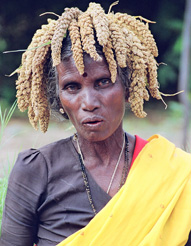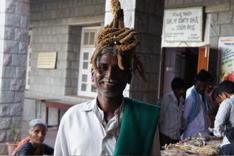What are millets?
Millets are small-seeded grasses that are hardy and grow well in dry zones as rain-fed crops, under marginal conditions of soil fertility and moisture. Millets are one of the oldest foods known to humans and possibly the first cereal grain to be used for domestic purposes.
Millets are small-seeded grasses that are hardy and grow well in dry zones as rain-fed crops, under marginal conditions of soil fertility and moisture. Millets are one of the oldest foods known to humans and possibly the first cereal grain to be used for domestic purposes.
Millets are also unique due to their short growing season. They can develop from planted seeds to mature, ready to harvest plants in as little as 65 days. This is important in heavily populated areas. When properly stored, whole millets will keep for two or more years.
Why eat millets?
Nutrition:
They are highly nutritious, non-glutinous and not acid forming foods. Hence they are soothing and easy to digest. They are considered to be the least allergenic and most digestible grains available. Compared to rice, especially polished rice, millets release lesser percentage of glucose and over a longer period of time. This lowers the risk of diabetes (More here).
Nutrition:
They are highly nutritious, non-glutinous and not acid forming foods. Hence they are soothing and easy to digest. They are considered to be the least allergenic and most digestible grains available. Compared to rice, especially polished rice, millets release lesser percentage of glucose and over a longer period of time. This lowers the risk of diabetes (More here).
Millets are particularly high in minerals like iron, magnesium, phosphorous and potassium. Finger millet (Ragi) is the richest in calcium content, about 10 times that of rice or wheat. Click here for the nutrient composition of millets as compared to wheat and rice.
Environmental:
Unlike rice and wheat that require many inputs in terms of soil fertility and water, millets grow well in dry regions as rainfed crops. By eating millets, we will be encouraging farmers in dryland areas to grow crops that are best suited for those regions. This is a step towards sustainable cropping practices where by introducing diversity in our diets, we respect the biodiversity in nature rather than forcefully changing cropping patterns to grow wheat and rice everywhere.
Unlike rice and wheat that require many inputs in terms of soil fertility and water, millets grow well in dry regions as rainfed crops. By eating millets, we will be encouraging farmers in dryland areas to grow crops that are best suited for those regions. This is a step towards sustainable cropping practices where by introducing diversity in our diets, we respect the biodiversity in nature rather than forcefully changing cropping patterns to grow wheat and rice everywhere.
Small farmers:


There are many co-operatives of small farmers that are working on providing livelihoods to farmers while at the same time focusing on ecological preservation. In dryland regions, these groups encourage the farmers to produce crops that are local to those regions, that thrive best there – millets. By incorporating millets into our diets, we will be supporting these groups. Learn more about these groups here.
What kinds of millets are available?
- Barnyard Millet (Hindi: Jhangora; Tamil: Kuthiravaali; Telugu: Odalu, ఓదలు)
- Finger Millet (Hindi: Mandua; Tamil: Kelvargu; Telugu: Ragulu రాగులు; Kannada:Ragi; Malayalam: Koovarugu)
- Foxtail Millet (Hindi: Kangni; Tamil: Tenai; Telugu: Korra కొర్రలు; Kannada:Navane; Malayalam: Thina)
- Kodo Millet (Hindi: Kodra; Tamil: Varagu; Telugu: Arikelu అరికెలు; Kannada:Harka)
- Little Millet (Hindi: Kutki; Tamil: Samai; Telugu: Sama సామాలు; Kannada: Same; Malayalam: Chama)
- Pearl Millet (Hindi: Bajra, Tamil: Kambu, Telugu: Gantilu గంటిలు, సజ్జలు, Kannada: Sajje)
- Proso Millet (Hindi: Barri; Tamil: Panivaragu; Telugu: Varigulu వరిగలు; Kannada:Baragu)
- Sorghum (Hindi: Jowar; Tamil: Cholam; Telugu: Jonna జొన్నలు; Kannada: Jola; Malayalam: Cholum)
How do I cook them?
Most millets can be cooked like rice. Millets can replace rice in various dishes such as idli, dosa, payasam/kheer. Millet flour can be used to make rotis. Click here for some recipes.
Most millets can be cooked like rice. Millets can replace rice in various dishes such as idli, dosa, payasam/kheer. Millet flour can be used to make rotis. Click here for some recipes.
Where can I buy millets?
Earth 360 Ventures, Kadiri, Andhra Pradesh. Email Dinesh at “millets dot dinesh at gmail dot com”.
Jaivik Mall, near Lalbagh Double Road gate. 080 65624197
Navadarshanam products: These can be purchased at any Namdhari Fresh outlet.
Timbaktu Organic products: To order, call 08559 202149 / 202335 / 202339
Svad Products: To order, send an email to “svad dot organic at gmail dot com”
References
“Bhoole Bisre Anaj – The Forgotten Foods”, Navdanya
This page has the following sub pages.
- Barnyard Millet
- Ragi / Finger Millet
- Foxtail Millet
- Kodo Millet
- Little Millet
- Pearl Millet
- Proso Millet
- Sorghum
- Anatomy of a Whole Grain Kernel
- Farming
- Processing
No comments:
Post a Comment